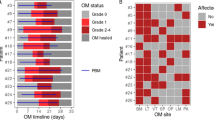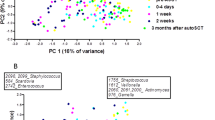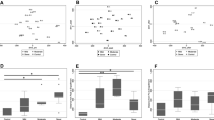Abstract
Severe oral mucositis occurs frequently in patients receiving hematopoietic stem cell transplantation (HCT). Oral mucosal bacteria can be associated with progression of oral mucositis, and systemic infection may occur via ulcerative oral mucositis. However, little information is available regarding the oral microbiota after HCT. Here, PCR-denaturing gradient gel electrophoresis (DGGE) was performed to characterize the oral mucosal microbiota, which can be affected by antibiotics, before and after HCT. Sixty reduced-intensity HCT patients were enrolled. Three patients with the least antibiotic use (quinolone prophylaxis and/or β-lactam monotherapy group) and three patients with the most antibiotic use (β-lactam-glycopeptide combination therapy group) were selected. Bacterial DNA samples obtained from the oral mucosa before and after HCT were subjected to PCR-DGGE. The trajectory of oral mucositis was evaluated. The oral mucosal microbiota in the β-lactam-glycopeptide combination therapy group was different from that in the quinolone prophylaxis and/or β-lactam monotherapy group, and Staphylococcus spp. and Enterococcus spp. were identified. Lautropia mirabilis was dominant in one patient. Ulcerative oral mucositis was observed only in the β-lactam-glycopeptide combination therapy group. In conclusion, especially with the use of strong antibiotics, such as glycopeptides, the oral mucosal microbiota differed completely from that under normal conditions and consisted of Staphylococcus spp., Enterococcus spp., and unexpectedly L. mirabilis. The normal oral microbiota consists not only of bacteria, but these unexpected bacteria could be involved in the pathophysiology as well as systemic infection via oral mucositis. Our results can be used as the basis for future studies in larger patient populations.



Similar content being viewed by others
References
Arias CA, Murray BE (2012) The rise of the Enterococcus: beyond vancomycin resistance. Nat Rev Microbiol 10:266–278. https://doi.org/10.1038/nrmicro2761
Bow EJ (2005) Management of the febrile neutropenic cancer patient: lessons from 40 years of study. Clin Microbiol Infect: Off Publ Eur Soc Clin Microbiol Infect Dis 11(Suppl 5):24–29. https://doi.org/10.1111/j.1469-0691.2005.01240.x
Bucaneve G, Micozzi A, Menichetti F, Martino P, Dionisi MS, Martinelli G, Allione B, D'Antonio D, Buelli M, Nosari AM, Cilloni D, Zuffa E, Cantaffa R, Specchia G, Amadori S, Fabbiano F, Deliliers GL, Lauria F, Foà R, del Favero A, Gruppo Italiano Malattie Ematologiche dell'Adulto (GIMEMA) Infection Program (2005) Levofloxacin to prevent bacterial infection in patients with cancer and neutropenia. N Engl J Med 353:977–987. https://doi.org/10.1056/NEJMoa044097
Colombo AP et al (2009) Comparisons of subgingival microbial profiles of refractory periodontitis, severe periodontitis, and periodontal health using the human oral microbe identification microarray. J Periodontol 80:1421–1432. https://doi.org/10.1902/jop.2009.090185
Colombo AP et al (2012) Impact of periodontal therapy on the subgingival microbiota of severe periodontitis: comparison between good responders and individuals with refractory periodontitis using the human oral microbe identification microarray. J Periodontol 83:1279–1287. https://doi.org/10.1902/jop.2012.110566
Eckburg PB, Bik EM, Bernstein CN, Purdom E, Dethlefsen L, Sargent M, Gill SR, Nelson KE, Relman DA (2005) Diversity of the human intestinal microbial flora. Science 308:1635–1638. https://doi.org/10.1126/science.1110591
Fischer SG, Lerman LS (1983) DNA fragments differing by single base-pair substitutions are separated in denaturing gradient gels: correspondence with melting theory. Proc Natl Acad Sci U S A 80:1579–1583
Fujimoto C, Maeda H, Kokeguchi S, Takashiba S, Nishimura F, Arai H, Fukui K, Murayama Y (2003) Application of denaturing gradient gel electrophoresis (DGGE) to the analysis of microbial communities of subgingival plaque. J Periodontal Res 38:440–445
Gerner-Smidt P et al (1994) Lautropia mirabilis gen. nov., sp. nov., a gram-negative motile coccus with unusual morphology isolated from the human mouth. Microbiology 140(Pt 7):1787–1797. https://doi.org/10.1099/13500872-140-7-1787
Hughes WT et al (2002) 2002 guidelines for the use of antimicrobial agents in neutropenic patients with cancer. Clin Infect Dis: Off Publ Infect Dis Soc Am 34:730–751. https://doi.org/10.1086/339215
Kern WV, Klose K, Jellen-Ritter AS, Oethinger M, Bohnert J, Kern P, Reuter S, Baum H, Marre R (2005) Fluoroquinolone resistance of Escherichia coli at a cancer center: epidemiologic evolution and effects of discontinuing prophylactic fluoroquinolone use in neutropenic patients with leukemia. Eur J Clin Microbiol Infect Dis 24:111–118. https://doi.org/10.1007/s10096-005-1278-x
Kolbinson DA, Schubert MM, Flournoy N, Truelove EL (1988) Early oral changes following bone marrow transplantation. Oral Surg, Oral Med, Oral Pathol 66:130–138
Muto CA, Pokrywka M, Shutt K, Mendelsohn AB, Nouri K, Posey K, Roberts T, Croyle K, Krystoflak S, Patel-Brown S, Pasculle AW, Paterson DL, Saul M, Harrison LH (2005) A large outbreak of Clostridium difficile-associated disease with an unexpected proportion of deaths and colectomies at a teaching hospital following increased fluoroquinolone use. Infect Control Hosp Epidemiol 26:273–280. https://doi.org/10.1086/502539
Muyzer G, Smalla K (1998) Application of denaturing gradient gel electrophoresis (DGGE) and temperature gradient gel electrophoresis (TGGE) in microbial ecology. Antonie Van Leeuwenhoek 73:127–141
Muyzer G, de Waal EC, Uitterlinden AG (1993) Profiling of complex microbial populations by denaturing gradient gel electrophoresis analysis of polymerase chain reaction-amplified genes coding for 16S rRNA. Appl Environ Microbiol 59:695–700
Myers RM, Maniatis T, Lerman LS (1987) Detection and localization of single base changes by denaturing gradient gel electrophoresis. Methods Enzymol 155:501–527
Nishijima M, Lindsay DJ, Hata J, Nakamura A, Kasai H, Ise Y, Fisher CR, Fujiwara Y, Kawato M, Maruyama T (2010) Association of thioautotrophic bacteria with deep-sea sponges. Mar Biotechnol (NY) 12:253–260. https://doi.org/10.1007/s10126-009-9253-7
Pepin J, Saheb N, Coulombe MA, Alary ME, Corriveau MP, Authier S, Leblanc M, Rivard G, Bettez M, Primeau V, Nguyen M, Jacob CE, Lanthier L (2005) Emergence of fluoroquinolones as the predominant risk factor for Clostridium difficile-associated diarrhea: a cohort study during an epidemic in Quebec. Clin Infect Dis: Off Publ Infect Dis Soc Am 41:1254–1260. https://doi.org/10.1086/496986
Rossmann SN, Wilson PH, Hicks J, Carter B, Cron SG, Simon C, Flaitz CM, Demmler GJ, Shearer WT, Kline MW (1998) Isolation of Lautropia mirabilis from oral cavities of human immunodeficiency virus-infected children. J Clin Microbiol 36:1756–1760
Schabereiter-Gurtner C et al (2001) 16S rDNA-based identification of bacteria from conjunctival swabs by PCR and DGGE fingerprinting. Invest Ophthalmol Vis Sci 42:1164–1171
Shaddox LM, Huang H, Lin T, Hou W, Harrison PL, Aukhil I, Walker CB, Klepac-Ceraj V, Paster BJ (2012) Microbiological characterization in children with aggressive periodontitis. J Dent Res 91:927–933. https://doi.org/10.1177/0022034512456039
Soga Y, Saito T, Nishimura F, Ishimaru F, Mineshiba J, Mineshiba F, Takaya H, Sato H, Kudo C, Kokeguchi S, Fujii N, Tanimoto M, Takashiba S (2008) Appearance of multidrug-resistant opportunistic bacteria on the gingiva during leukemia treatment. J Periodontol 79:181–186. https://doi.org/10.1902/jop.2008.070205
Soga Y, Maeda Y, Ishimaru F, Tanimoto M, Maeda H, Nishimura F, Takashiba S (2011) Bacterial substitution of coagulase-negative staphylococci for streptococci on the oral mucosa after hematopoietic cell transplantation. Support Care Cancer: Off J Multinational Assoc Support Care Cancer 19:995–1000. https://doi.org/10.1007/s00520-010-0923-9
Takahashi K, Soga Y, Murayama Y, Udagawa M, Nishimoto H, Sugiura Y, Maeda Y, Tanimoto M, Takashiba S (2010) Oral mucositis in patients receiving reduced-intensity regimens for allogeneic hematopoietic cell transplantation: comparison with conventional regimen. Support Care Cancer: Off J Multinational Assoc Support Care Cancer 18:115–119. https://doi.org/10.1007/s00520-009-0637-z
Tardieu C, Cowen D, Thirion X, Franquin JC (1996) Quantitative scale of oral mucositis associated with autologous bone marrow transplantation. Eur J Cancer. Part B Oral Oncol 32B:381–387
Vera-Llonch M, Oster G, Ford CM, Lu J, Sonis S (2007) Oral mucositis and outcomes of allogeneic hematopoietic stem-cell transplantation in patients with hematologic malignancies. Support Care Cancer: Off J Multinational Assoc Support Care Cancer 15:491–496. https://doi.org/10.1007/s00520-006-0176-9
Acknowledgments
PCR-DGGE analysis and sequence analysis were performed by a professional technical analysis service (Techno Suruga Lab Service, Shizuoka, Japan). We are grateful to Ms. Junko Tomita and Mr. Shunsuke Takahashi, technicians of Techno Suruga Laboratory Co., Ltd., for performing these analyses. We are also grateful to Ms. Motoko Nose, medical technologist of Clinical Laboratory, Central Clinical Department, Okayama University Hospital, Okayama, Japan, for the advice.
Funding
This study was partly supported by a Grant-in-Aid from JSPS KAKENHI Grant Number JP26462881 (to Y.S.), a Grant-in-Aid for the COE projects by MEXT, Japan, entitled “Center of excellence for molecular and gene targeting therapies with micro-dose molecular imaging modalities” (to Y.S.), and a Grant-in-Aid for the COE projects by Ministry of Health, Labour and Welfare, Japan, entitled “Designated regional hub hospital promoting hematopoietic stem cell transplantation” (to M.M.).
Author information
Authors and Affiliations
Corresponding author
Ethics declarations
All subjects provided informed consent, and the study was approved by the Ethics Committee of Okayama University Graduate School of Medicine, Dentistry, and Pharmaceutical Sciences (Approval No. 902).
Conflict of interest
The authors declare that they have no conflicts of interest.
Rights and permissions
About this article
Cite this article
Muro, M., Soga, Y., Higuchi, T. et al. Unusual oral mucosal microbiota after hematopoietic cell transplantation with glycopeptide antibiotics: potential association with pathophysiology of oral mucositis. Folia Microbiol 63, 587–597 (2018). https://doi.org/10.1007/s12223-018-0596-1
Received:
Accepted:
Published:
Issue Date:
DOI: https://doi.org/10.1007/s12223-018-0596-1




